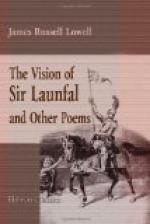“According to the mythology of the Romancers, the San Greal, or Holy Grail, was the cup out of which Jesus Christ partook of the last supper with his disciples. It was brought into England by Joseph of Arimathea, and remained there, an object of pilgrimage and adoration, for many years in the keeping of his lineal descendants. It was incumbent upon those who had charge of it to be chaste in thought, word, and deed; but, one of the keepers having broken this condition, the Holy Grail disappeared. From that time it was a favorite enterprise of the Knights of Arthur’s court to go in search of it. Sir Galahad was at last successful in finding it, as may be read in the seventeenth book of the Romance of King Arthur. Tennyson has made Sir Galahad the subject of one of the most exquisite of his poems.
“The plot (if I may give that name to anything so slight) of the following poem is my own, and, to serve its purposes, I have enlarged the circle of competition in search of the miraculous cup in such a manner as to include not only other persons than the heroes of the Round Table, but also a period of time subsequent to the date of King Arthur’s reign.”
In the last sentence there is a sly suggestion of Lowell’s playfulness. Of course every one may compete in the search for the Grail, and the “time subsequent to King Arthur’s reign” includes the present time. The Romance of King Arthur is the Morte Darthur of Sir Thomas Malory. Lowell’s specific indebtedness to the medieval romances extended only to the use of the symbol of consecration to some noble purpose in the search for the Grail, and to the name of his hero. It is a free version of older French romances belonging to the Arthurian cycle. Sir Launfal is the title of a poem written by Sir Thomas Chestre in the reign of Henry VI, which may be found in Ritson’s Ancient English Metrical Romances. There is nothing suggestive of Lowell’s poem except the quality of generosity in the hero, who—
“gaf
gyftys largelyche,
Gold and sylver; and clodes
ryche,
To squyer and
to knight.”
One of Lowell’s earlier poems, The Search, contains the germ of The Vision of Sir Launfal. It represents a search for Christ, first in nature’s fair woods and fields, then in the “proud world” amid “power and wealth,” and the search finally ends in “a hovel rude” where—
“The King
I sought for meekly stood:
A
naked, hungry child
Clung
round his gracious knee,
And a poor hunted slave looked
up and smiled
To bless the smile
that set him free.”
And Christ, the seeker learns, is not to be found by wandering through the world.
“His throne is with the outcast and the weak.”
A similar fancy also is embodied in a little poem entitled A Parable. Christ goes through the world to see “How the men, my brethren, believe in me,” and he finds “in church, and palace, and judgment-hall,” a disregard for the primary principles of his teaching.




